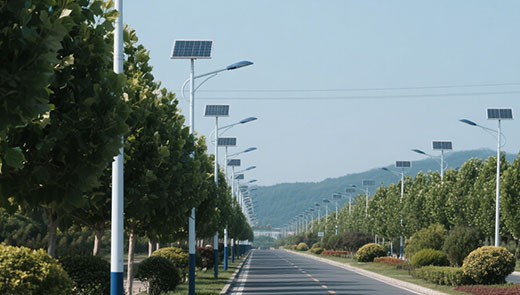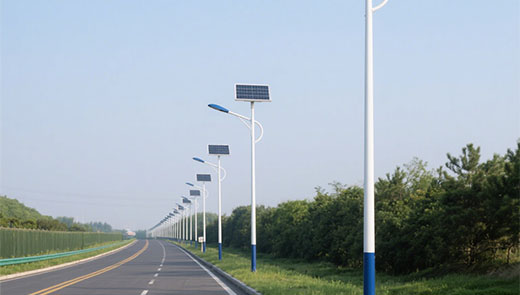Install solar street lights on city streets
May 16, 2023
Solar street light is a kind of lighting equipment that uses solar energy to generate electricity and store energy to provide lighting. Compared with traditional street lights, solar street lights have the following characteristics:
 1. Green and environmental protection: solar street lights absorb sunlight through solar panels and convert it into electrical energy, without using traditional power supply, reducing dependence on traditional energy, reducing emissions of carbon dioxide and other pollutants, and being more environmentally friendly.
1. Green and environmental protection: solar street lights absorb sunlight through solar panels and convert it into electrical energy, without using traditional power supply, reducing dependence on traditional energy, reducing emissions of carbon dioxide and other pollutants, and being more environmentally friendly.
2. Energy saving and high efficiency: Solar street lights use solar energy to generate electricity. During the day, the solar panel converts solar energy into electrical energy and stores it in the battery. At night, it is powered by a battery to provide lighting. Compared with traditional street lights that need to be connected to the grid for power supply, solar street lights are more energy-saving and efficient, reducing energy consumption.
3. Independent operation: The solar street light system has the function of self-illumination, without external power support, and is not affected by power failure or power interruption. This makes solar streetlights ideal for remote locations, rural areas, or where power supply is limited following a disaster.
4. Easy to install and maintain: Solar streetlights do not require electrical wiring, reducing the complexity and cost of installation. Solar street lighting systems are usually composed of solar panels, batteries, LED lights, and controllers, etc., with a modular design that is easier to install and maintain.
5. Long life and stability: Solar street lights adopt LED lighting technology, LED lamps have a long life, low energy consumption, high brightness, and provide uniform lighting effects. The solar street light system also has lightning protection, waterproof, dustproof, and wind resistance capabilities, and can adapt to various harsh outdoor environments.
In general, solar street lights have the characteristics of green environmental protection, energy saving, high efficiency, independent operation, easy installation and maintenance, long life, and stability. It is a sustainable lighting solution and is widely used in urban street lighting and public Area lighting.

2. Energy saving and high efficiency: Solar street lights use solar energy to generate electricity. During the day, the solar panel converts solar energy into electrical energy and stores it in the battery. At night, it is powered by a battery to provide lighting. Compared with traditional street lights that need to be connected to the grid for power supply, solar street lights are more energy-saving and efficient, reducing energy consumption.
3. Independent operation: The solar street light system has the function of self-illumination, without external power support, and is not affected by power failure or power interruption. This makes solar streetlights ideal for remote locations, rural areas, or where power supply is limited following a disaster.
4. Easy to install and maintain: Solar streetlights do not require electrical wiring, reducing the complexity and cost of installation. Solar street lighting systems are usually composed of solar panels, batteries, LED lights, and controllers, etc., with a modular design that is easier to install and maintain.
5. Long life and stability: Solar street lights adopt LED lighting technology, LED lamps have a long life, low energy consumption, high brightness, and provide uniform lighting effects. The solar street light system also has lightning protection, waterproof, dustproof, and wind resistance capabilities, and can adapt to various harsh outdoor environments.
In general, solar street lights have the characteristics of green environmental protection, energy saving, high efficiency, independent operation, easy installation and maintenance, long life, and stability. It is a sustainable lighting solution and is widely used in urban street lighting and public Area lighting.




